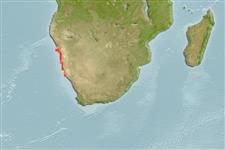>
Eupercaria/misc (Various families in series Eupercaria) >
Sparidae (Porgies)
Etymology: Chrysoblephus: Greek, chrysos = golden + Greek, blepo, blepharizo = to watch (Ref. 45335).
More on author: Valenciennes.
Environment: milieu / climate zone / depth range / distribution range
Οικολογία
Θαλασσινό(ά) βενθικό(ς); εύρος βάθους 1 - 100 m (Ref. 3198). Tropical; 21°S - 28°S
Southeast Atlantic: northern Namibia to northern Natal, South Africa; also reported from Mauritius.
Length at first maturity / Μέγεθος / Βάρος / Age
Maturity: Lm 18.1 range ? - 22.5 cm
Max length : 50.0 cm TL αρσενικό/απροσδιόριστο; (Ref. 3507); common length : 32.0 cm TL αρσενικό/απροσδιόριστο; (Ref. 3507); μεγ. δημοσιευμένο βάρος: 4.2 kg (Ref. 3670)
Short description
Κλείδες προσδιορισμού | Μορφολογία | Μορφομετρία
Ραχιαίες άκανθες (συνολικά) : 11 - 12; Μαλακές ραχιαίες ακτίνες (συνολικά) : 10 - 11; Εδρικές άκανθες: 3; Μαλακές εδρικές ακτίνες: 7 - 9. Usually reddish orange in color, but sometimes blue with a white patch on the side (Ref. 3198).
Occurs above rocky bottoms in deeper water to 100 m but often caught from shore. Juveniles occur in shallow-water beds of seaweed where they feed on minute crustacean (Ref. 3670). Feeds on mollusks, crustaceans, worms and fish. Females transform into territorial males with growth (Ref. 3198). Voracious but sluggish, takes any bait. Good food fish (Ref. 3198). Sold fresh (Ref. 3507). It is parasitised by the monogenean Anoplodiscus cirrusspiralis on the fins and body surface (Ref. 124057).
Also Ref. 28504.
Bauchot, M.-L. and M.M. Smith, 1984. Sparidae. In W. Fischer and G. Bianchi (eds.) FAO species identification sheets for fishery purposes. Western Indian Ocean (Fishing Area 51). volume 4. [var. pag.] FAO, Rome. (Ref. 3507)
IUCN Red List Status (Ref. 130435: Version 2024-1)
Threat to humans
Harmless
Human uses
αλιεία: Εμπορικό(ά); αλιεία αναψυχής: ναί; Ενυδρείο: Δυνητικό
Εργαλεία
Special reports
Download XML
Διαδικτυακές πηγές
Estimates based on models
Phylogenetic diversity index (Ref.
82804): PD
50 = 0.5156 [Uniqueness, from 0.5 = low to 2.0 = high].
Bayesian length-weight: a=0.01778 (0.01102 - 0.02869), b=3.00 (2.86 - 3.14), in cm total length, based on LWR estimates for this species & Genus-body shape (Ref.
93245).
Τροφικό Επίπεδο (Ref.
69278): 4.0 ±0.0 se; based on diet studies.
Ελαστικότητα (Ref.
120179): Μεσαίο(α), ελάχιστος χρόνος για διπλασιασμό πληθυσμού 1,4 - 4,4 έτη (K=0.16).
Fishing Vulnerability (Ref.
59153): Moderate to high vulnerability (54 of 100).
Nutrients (Ref.
124155): Calcium = 105 [50, 201] mg/100g; Iron = 0.941 [0.508, 1.907] mg/100g; Protein = 18.7 [17.4, 19.9] %; Omega3 = 0.199 [0.111, 0.369] g/100g; Selenium = 57.6 [26.0, 123.7] μg/100g; VitaminA = 14.8 [3.9, 54.0] μg/100g; Zinc = 0.862 [0.566, 1.286] mg/100g (wet weight);
